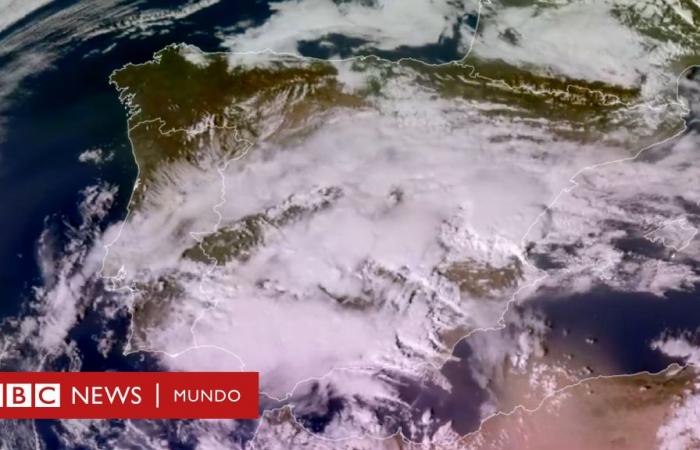
Image source, AEMET
- Author, Writing
- Author's title, BBC News World
- October 30, 2024
Updated October 31, 2024
More than 150 people died and dozens remain missing in severe flooding that mainly affected the Valencia region in eastern Spain.
In a few hours, the equivalent of a year's worth of rain fell in some areas, causing large floods that devastated entire towns, leaving thousands of people trapped.
In some places they recorded more than 500 liters per square meter.
The precipitation, which came accompanied by strong winds and tornadoes, was caused by a meteorological phenomenon known as Isolated Depression at High Levels (DANA) which has affected a large area of the south and east of Spanish territory.
A common phenomenon in the Mediterranean
The term DANA began to be used by Spanish meteorologists a few decades ago to differentiate it from the more generic “cold drop”, which is usually used to refer to any situation of intense and abundant rain, especially when it occurs on the Mediterranean coast of the Iberian Peninsula during autumn.
The DANA is a phenomenon in which a mass of very cold polar air becomes isolated and begins to circulate at very high altitudes (between 5,000 and 9,000 meters), far from the influence of the circulation of the atmosphere.
Then, when it collides with the warmer and more humid air that usually exists in the Mediterranean Sea, it generates strong storms, especially at the end of the northern summer and the beginning of autumn, when maritime temperatures are higher.
“Crea an intensely unstable environment, and that's where the air rises. Very quickly it allows the storm clouds to actually fly, aided and abetted by the winds hitting higher ground and also lifting. And the higher the storm clouds are, the more moisture there is in them,” explained BBC meteorologist Matt Taylor.
This phenomenon can last several days and is accompanied by a drop in temperatures, a very unstable environment and extreme weather events, as is being seen these days on the east coast of Spain.
Unlike a common storm, which moves towards the east, a DANA can remain stranded in the same place for several days or even move towards the west (which is called retrogression), as explained by the Spanish Meteorological Agency (Aemet). .
Not all DANAs create extreme weather conditions like the latter.
Its destructive potential appears precisely when mixed with warm land and sea temperatures.
“DANAs are a relatively frequent structure in our latitudes (Spain) and, luckily, most of them do not become so newsworthy,” says Aemet meteorologist Delia Gutiérrez on the agency's blog.
Historically In Spain there have been DANAs well remembered for their destructive consequences, such as the one in 1973, which affected Almería, Granada and Murcia, in the southeast of the country, and left many human and material losses in its wake.
The Aemet has described the current storm as the “most adverse of the century in the Valencian Community.”
“It has been a historic storm, on par with the great Mediterranean storms and among the three most intense of the last century in the region,” they add.
Image source, Getty Images
Climate change
The increasing frequency of DANAs and the intensification of rainfall associated with them are closely linked to climate change, according to experts.
He progressive increase in the temperature of the Mediterranean Sea It facilitates the creation of conditions so that there is more energy and humidity necessary for a more powerful DANA to occur.
“We are seeing more of these phenomena as our climate warms,” explained BBC meteorologist Matt Taylor.
“Although such events have happened in the past, they are becoming more common,” Taylor said.
Last year, a study by the American Meteorological Society detected an increase in DANAs since the 1960s on a global scale.
Image source, Getty Images
Subscribe here to our new newsletter to receive a selection of our best content of the week every Friday.
And remember that you can receive notifications in our app. Download the latest version and activate them.





